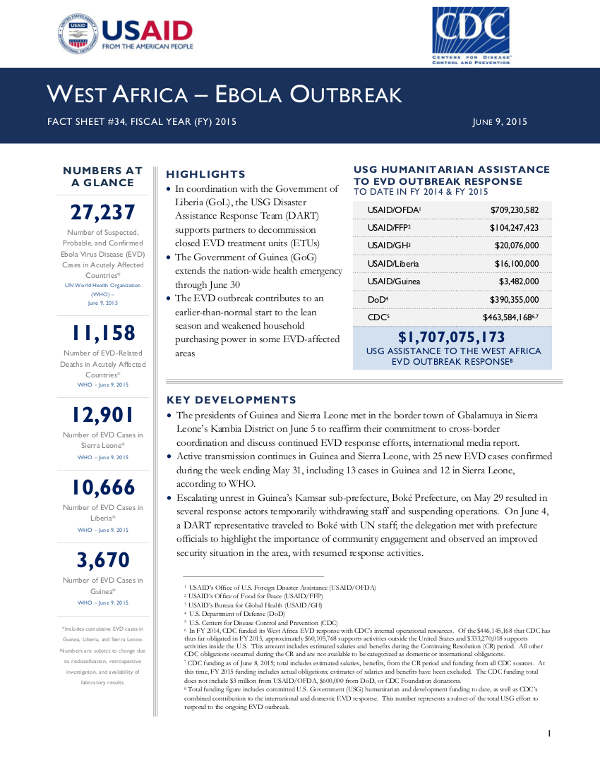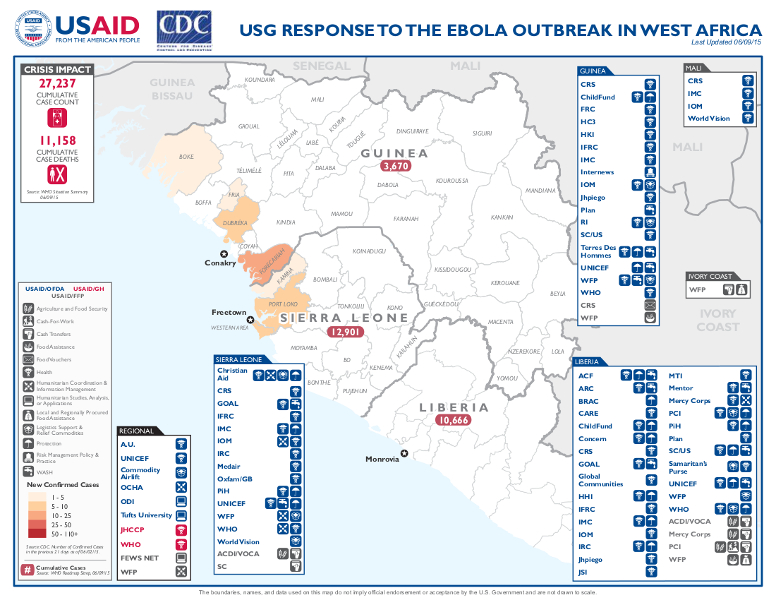June 9, 2015
HIGHLIGHTS
Ebola Response
Visit our main West Africa Ebola Outbreak page to learn more about how we're responding to the West Africa Ebola outbreak, and what you can do to help.
- In coordination with the Government of Liberia (GoL), the USG Disaster Assistance Response Team (DART) supports partners to decommission closed EVD treatment units (ETUs).
- The Government of Guinea (GoG) extends the nation-wide health emergency through June 30.
- The EVD outbreak contributes to an earlier-than-normal start to the lean season and weakened household purchasing power in some EVD-affected areas.
West Africa Fact Sheet #34 - 06-09-2015 ![]() (pdf - 356k)
(pdf - 356k)
KEY DEVELOPMENTS
- The presidents of Guinea and Sierra Leone met in the border town of Gbalamuya in Sierra Leone’s Kambia District on June 5 to reaffirm their commitment to cross-border coordination and discuss continued EVD response efforts, international media report.
- Active transmission continues in Guinea and Sierra Leone, with 25 new EVD cases confirmed during the week ending May 31, including 13 cases in Guinea and 12 in Sierra Leone, according to WHO.
- Escalating unrest in Guinea’s Kamsar sub-prefecture, Boké Prefecture, on May 29 resulted in several response actors temporarily withdrawing staff and suspending operations. On June 4, a DART representative traveled to Boké with UN staff; the delegation met with prefecture officials to highlight the importance of community engagement and observed an improved security situation in the area, with resumed response activities.
REGIONAL
WHO reported 25 confirmed cases of EVD between May 25–31, including 13 cases in Guinea and 12 in Sierra Leone. New cases occurred across four western Guinean prefectures and three Sierra Leonean districts. The source of transmission for some cases remains unknown, highlighting continued undetected chains of transmission, WHO reports.
West Africa Map - 06-09-2015 ![]() (pdf - 498k)
(pdf - 498k)
WHO notes that the onset of the rainy season throughout the region may impede response efforts. Acting Special Representative of the Secretary-General for the UN Mission for Ebola Emergency Response (UNMEER) Peter Graaff stated that the rainy season will also likely increase other diseases—such as malaria—that manifest symptoms similar to EVD, international media report.
During the June 5 border meeting, Presidents Ernest Bai Koroma of Sierra Leone and Alpha Condé of Guinea discussed cross-border collaboration as both countries continue the process of halting EVD transmission. The presidents also discussed common approaches for dead body management, measures to close health facilities not complying with EVD response directives, and the need for local authorities to reinforce strict public health measures.
Liberia
In Liberia, the DART is working with partners and GoL officials to deconstruct and decontaminate closed ETUs and to properly dispose of or transfer remaining assets. As of May 28, WHO—on behalf of the GoL—had approved decommissioning plans for all ten of the USAID/OFDA-supported ETUs managed by partner PAE. The majority of the remaining ETUs that do not yet have WHO-approved decommissioning plans are scheduled to remain open in the coming months.
On June 3, a DART representative visited the site of the USAID/OFDA-supported Gbediah Town ETU in River Cess County; at the time of the visit, PAE had deconstructed and cleared approximately 95 percent of the site. The DART member also met with county officials to discuss the asset disposition process. Over the coming weeks, the DART plans to similarly monitor deconstruction and asset disposition processes at other USAID/OFDA-supported ETU sites.
The USG continues to support the GoL and other response actors to maintain surveillance efforts in Liberia. DART and CDC representatives continue to attend regular post-EVD transition meetings and discuss activities with GoL officials. USAID/OFDA partner MENTOR Initiative is supporting transition efforts through conducting community outreach and social mobilization activities to maintain EVD awareness, supporting triage and isolation capacity, and supervising surveillance and referral methods in pharmacy stores and private health clinics. With USAID/OFDA support, a nongovernmental organization (NGO) consortium led by the International Rescue Committee (IRC) is supporting Montserrado County—where Liberia confirmed its last EVD case—to strengthen infectious disease surveillance and infection prevention and control (IPC) protocols.
With USAID/OFDA support, NGO Global Communities continues activities to reduce the risk of EVD resurgence in Liberia. As of May 30, the NGO continued to support more than 40 safe burial teams, 10 disinfection teams, and 20 ambulances, facilitating safe and dignified burials and the disposal of medical waste from Liberian hospitals. Global Communities is also coordinating with the GoL to increase local ownership of the border surveillance process, convening meetings in areas that border Guinea and Sierra Leone to establish guidelines for maintaining safe border crossings and documenting informal crossing points.
Sierra Leone
Sierra Leone reported 12 confirmed EVD cases during the week ending May 31, including eight cases from Port Loko District; three cases in the capital city of Freetown, Western Urban District; and one case in Kambia District—the first new case in Kambia for more than 14 days, according to WHO. Of the total caseload, seven—or just over half of all cases—came from known contacts of previous EVD cases.
In response to the number of cases occurring in Port Loko’s Kaffu Bullom chiefdom during the reporting period, the UN Children’s Fund (UNICEF) and other response actors supported a house-to-house mobilization and case finding campaign in the community. UNICEF reports that the efforts reached more than 900 households, or 4,000 people.
USAID/OFDA recently committed an additional $8 million to support WHO’s response efforts in Sierra Leone, including active surveillance and contact tracing and supporting IPC in health care facilities. To date, USAID/OFDA has provided $12 million for WHO’s activities in Sierra Leone.
Between May 27 and June 2, a CDC-supported ambulance sensitization project visited three villages in Kambia each day and spoke with an average of 100 community members at each site. Peace Corps, WHO, and the UK Department for International Development also supported the project. Previously, research found a lack of information concerning EVD transmission and treatment resulted in fear, inhibiting people from seeking assistance for suspected EVD cases. In particular, many people regard ambulances with suspicion—having seen few, if any, ambulances prior to the EVD outbreak, some communities associate the vehicles with disease and death. To dispel myths and educate communities, a team of response workers—including an ambulance driver, nurse, social mobilizer, decontaminator, family liaison member, contact tracer, and EVD survivor—traveled to Kambian communities to explain their individual roles during a response call and to allow people to view the ambulance close-up. DART staff observing the project noted a high degree of public engagement with the project team.
Guinea
On June 5, President Condé extended the nation-wide health emergency until the end of June, international media report. President Condé initially declared a health emergency in August 2014, renewing the declaration in March 2015.
During the week ending May 31, Guinea reported 13 confirmed EVD cases; seven of those cases occurred in Forécariah Prefecture, four occurred in Dubréka Prefecture, and Boké and Fria prefectures each reported one case, according to WHO.
During the reporting week, response actors reported obstacles to community engagement in all four prefectures. In Fria, community members attacked and threw stones at the car of a GoG official. Due to escalating unrest in Boké’s Kamsar sub-prefecture on May 29, several response actors, including the International Federation of Red Cross and Red Crescent Societies (IFRC), International Medical Corps (IMC), and WHO, withdrew staff and suspended operations.
As of June 3, USAID/OFDA partners reported that the security situation had improved and response activities had restarted, noting a large security presence in the area. Guinean Red Cross burial teams resumed work—between May 29 and June 2, most safe burial work halted. USAID/OFDA partner the Center for International Studies and Education (CECI) also resumed social mobilization efforts, and WHO surveillance teams resumed contact tracing efforts.
A representative of the DART traveled to Boké on June 4 with an interagency UN delegation; the delegation met with prefecture officials to reinforce the need for community engagement, emphasizing that community support for response efforts is critical to breaking EVD transmission chains. DART staff returned to Kamsar on June 8–9 to review response efforts.
With USAID/OFDA support, IMC opened a triage site on June 8 at the entrance of the Kassopo health center—the main public health facility in Kamsar’s largest town. The IMC-supported site is the first dedicated area for triaging patients at Kassopo.
FOOD SECURITY AND LIVELIHOODS
Current rice planting activities in some communities of Sierra Leone are occurring at below-average levels, according to mobile-based trader surveys conducted by the USAID-supported Famine Early Warning System (FEWS NET) in May 2015.
The depletion of household food stocks has resulted in an earlier-than-normal start to the lean season in some EVDaffected areas, FEWS NET reports. In addition, household incomes have remained below average due to the general economic slowdown across all three most-affected countries. This weakened household purchasing power is expected to contribute to Stressed—IPC 2—or Crisis—IPC 3—food insecurity in many areas across the region through September 2015. Households in Sierra Leone’s Bombali, Kailahun, Kenema, Kono, Port Loko and Tonkolili districts—where quarantines contributed to disruptions in agricultural production and market activities—are projected to face a crisis-level food security situation, characterized by possible increases in acute malnutrition, food consumption gaps, and unsustainable coping strategies, through the 2015 lean season, FEWS NET reports.
To date, USAID/FFP has provided more than $104 million in food assistance in support of the USG’s EVD response. USAID/FFP provides food assistance through a mix of targeted cash assistance, food vouchers, and in-kind food assistance, as appropriate and feasible. USAID/FFP has structured its response to incentivize local market actors, promote the recovery of market function, support agricultural production in the next growing season, and align with host government and USAID development priorities. USAID/FFP support for market-orientated activities includes: cash transfers and food vouchers to improve household access to nutritious foods; agricultural input vouchers to enable farming families to access high-quality seeds for planting; and cash-for-work income generation opportunities for vulnerable households.
PUBLIC DONATION INFORMATION
- The most effective way people can assist relief efforts is by making cash contributions to humanitarian organizations that are conducting relief operations. A list of humanitarian organizations that are accepting cash donations for disaster responses around the world can be found at www.interaction.org.
- USAID encourages cash donations because they allow aid professionals to procure the exact items needed (often in the affected region); reduce the burden on scarce resources (such as transportation routes, staff time, and warehouse space); can be transferred very quickly and without transportation costs; support the economy of the disaster-stricken region; and ensure culturally, dietary, and environmentally appropriate assistance.
More information can be found at:
- The Center for International Disaster Information: www.cidi.org or +1.202.821.1999.
- Information on relief activities of the humanitarian community can be found at www.reliefweb.int.
USAID/OFDA bulletins appear on the USAID website at what-we-









Comment
Make a general inquiry or suggest an improvement.